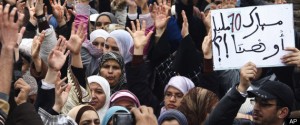Reuters
by Aziz El Yaakoubi
* Teachers protest comes after Tangier demonstrations
* Government pushing to continue reforms
* Weak growth in 2016 to add more pressure
Moroccan trainee teacher Lamia Zguiti took part in protests this month hoping to put a stop to planned cuts to education jobs. Instead, she got three broken bones in clashes with police.
Lamia, 24, joined a protest in the southern city of Inezgane against new plans to limit hiring in public education sector, just one of a raft of reforms that the Moroccan government hopes will revive public finances.
More than its North African neighbours, Morocco has been praised by international lenders for progress in controlling the high public spending that has plagued the region for years, even before the Arab Spring uprisings.
But touching public jobs, subsidies and other benefits that Moroccans have enjoyed for years is starting to create social tensions, triggering protests, sit-ins and strikes that will challenge the government’s resolve.
Lamia is one of 10,000 young, middle-class Moroccans who passed the exam to begin training to be teachers in public schools. On Oct. 8, the government said another exam would be required at the end of the year to be hired. Only 7,000 would pass the final tests, according to government data.
Moroccan police broke up most of the teacher trainee demonstrations across the kingdom, but the protesters say they will keep on fighting to cancel the government decrees. Dozens have been injured, including three who needed medical cares.
“I did not see it coming, I woke up in hospital, then I understood what happened to me,” Lamia told Reuters in the capital Rabat.
The police repression of the teacher protest has provoked a wave of solidarity in Moroccan social and local media and prompted Moroccan Prime Minister Abdelilah Benkirane’s government to order an inquiry into police violence.
“Maybe we will be the spark that will set Moroccan tinderbox on fire,” said Hamid El-Outmani, another teacher from the southern city of Ouarzazate, while showing Lamia’s medical reports.
IMF, WORLD BANK PRESSURE
Painful economic reforms to revive the economy and manage public finances are the toughest decisions facing Morocco’s Islamist led-government since it came to power amid pro-democracy protest in 2011 as the “Arab Spring” rocked the region.
Thousands took to the streets in the northern city of Tangier two months ago to protest over high prices for water and electricity, in Morocco’s largest demonstrations since those 2011 protests demanding political reforms.
“We cannot watch protesters closing the streets without doing anything … the law must be respected,” Abdelilah Benkirane told a parliamentary debate last week.
Morocco has been under pressure from international lenders, including the International Monetary Fund (IMF) and the World Bank, for structural reforms to ease the deficit since the country spent heavily to calm the 2011 protests.
Analysts say Benkirane has been bold and has done more than most North African countries to make painful changes such as ending fuel subsidies and freezing public sector hiring.
His government has also started another sensitive reform by adopting a bill earlier this month outlining planned pension reforms that unions have vowed to block, saying it would damage workers’ rights.
Morocco’s four largest labour unions have organised protests against the reform and said a general strike has been discussed. But so far they have not taken to the streets in massive numbers.
“This government has come to make the poor poorer and the rich richer,” said Mohamed El-Wafi, one of the leaders of Morocco’s biggest trade union UMT.
Helped by lower energy prices, Moroccan public finances have improved in the last two years with the budget deficit narrowing to 4.3 percent in 2015, down from 7.3 percent in 2012.
However, the government may face even further pressure in 2016 as weak growth is expected with a drought looming ahead after an exceptional cereal harvest in 2015.
The government sees the country’s gross domestic product (GDP) growing by only 3 percent in 2016, down from 5 percent last year, as agricultural output is expected to drop sharply. The central bank is forecasting only 2.6 percent this year.
But most analysts believe the Moroccan opposition remains relatively weak, disorganised and unable to take advantage of any social pressures in order to seek political change in the North African kingdom.
Even during the Arab Spring in 2011, Morocco’s protesters were only calling for limited reforms to the constitution and not the overthrow of the kingdom.
King Mohammed approved a new constitution devolving some of his powers to parliament and the government in political reforms the opposition said were only cosmetic.
“Those protests are not likely to have any immediate impact on government or regime stability or to escalate, because they lack sufficient support outside of the constituencies directly affected,” said Riccardo Fabiani, Middle East and North Africa analyst at Eurasia Group, a political risk agency.
“The biggest risks are in the medium to long term … when the protest could become the catalyst for a broader-based movement for political and social change.”
(Editing by Patrick Markey and Tom Heneghan)








